#Outdoor Rabbit Hutch
Explore tagged Tumblr posts
Text
Get an exclusive range of indoor rabbit hutch at a cheap price in Australia. Buy online pet cages with Afterpay. We have a small to a large outdoor bunny hutch.
0 notes
Text
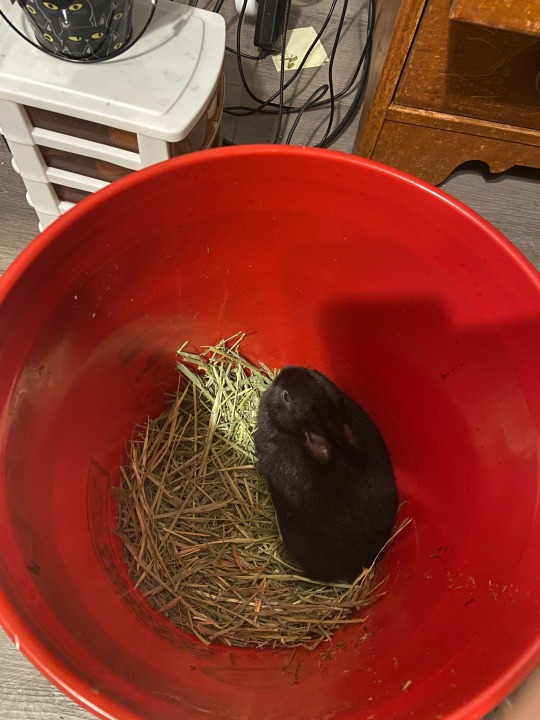
Rabbit bucket
#don’t worry this is just where I put her when I bring her out of the outdoor hutch and can’t hold her#she’s still being socialized#they’re still too small for my dog gate to keep them in lol#texty text#my rabbits
2 notes
·
View notes
Note
I saw your post about how peafowl are ... resource and knowledge intensive to keep. Is there a bird you would recommend for beginners? Are quail easy?
Compared to peafowl or even to chickens, yes, but that also depends on what you mean by quail. There are a BUNCH of species that are able to be kept in captivity, depending on where you live. If you're in the USA, coturnix and button quail are both domesticated species that do well in relatively small enclosures (think, a large rabbit hutch or one of those little "coops" from tractor supply co that they think are for chickens but are only suitable for babies at best). Most people that want to keep quail for meat or eggs are keeping coturnix not buttons but if you just want cute pets, button quail are adorable. The males of both species are LOUD though.
Coturnix do well eating game bird crumble mixed with layer crumble, as they need around 2.5-3% calcium if they're laying, which is about half what chickens need. They also need a higher protein than chickens, especially as babies (28-30 as babies, 21-26% as adults), or you don't get much in the way of eggs. Other than that, fresh water and a clean home and they're good to go.
The hens typically start laying by around 6-10 weeks (the Celadon gene can cause laying delays), the boys will be crowing on a similar timeline, so be sure you are okay with the noise or know what you're going to do with culls. Coturnix can be kept outdoors year round... button quail cannot, they need to be indoors if it's cold out. The biggest problems I've had with the coturnix is a) noise (which I've mostly bred out) and b) water in the winter. My water system only works when water can stay liquid. So, in the winter, the quail switch over to water bottles with 3D printed drinker bottoms, and those get changed 2+ times a day. They look kinda like this:

and c) aggression in a poorly-bred line. I don't see it much with my Celadon line anymore, but when I first got them, and in the new outcrossed babies, the males would be relentlessly either on the girls or fighting each other, and sometimes a girl would also do this, just start attacking everyone. I culled against it from day 1, and now they're fine, but I had a group of outcross boys that came from my Celadons x fresh blood and the boys were unmanageable immediately. It doesn't matter because I'm not keeping any of them, but I do worry it'll come back on birds I /want/ because the girls may carry that. So that's just something to be aware of, I guess. Ask the breeder about it before you buy.
If you just want "A Bird" and not specifically farm fowl: you want a pigeon or two! They bond to their humans or to each other, they do silly things and have Antics, there is a ton of easily accessible info about their nutrition (and their food is easy to acquire), care, and behavior, and there's always ones looking for homes. Since they were bred as companion and even work animals, not just as food, they socialize easily with humans and they can be kept indoors and unlike quail, their noises are pleasant.
Of course that doesn't dismiss the need to do your research on what it would entail to keep one (or two!), but at least that's easier to do well.
102 notes
·
View notes
Note
i swear why are rabbit people so unhinged. is there actually any detriment to rabbits living in well built rabbit hutches? they act like they would shrivel and die outside and like, buddy. i know you dont like hearing that but we raised rabbits for meat as well as companionship, pretty sure theyre fine in an outside hutch if the climate is right, they have no way to dig out and theyre safe from predators.
they also act like keeping a rabbit in a cage for safety overnight or when you go out is abuse. i’m all for free roaming rabbits but them having a temporary cage can’t be that bad? i mean even for dogs kennel training is beneficial…
Any time people send me an ask about rabbit keeping it feels like you’re trying to get me assassinated.
Despite FEELING the sniper dot on my forehead, I will say that yes there are circumstances you can safely keep rabbits in outdoor enclosures and in many cases that is preferable to keeping them exclusively inside and the latter is a standard largely set by fancy show rabbit keepers who require fur to be pristine for shows and thus not exposing rabbits to the dirty outdoors despite this being somewhat restrictive of many natural behaviors.
30 notes
·
View notes
Text




(Oakland, California) Meet Munchie, your future furry friend! Are you ready to welcome boundless joy into your home? Look no further! Munchie, a delightful rabbit with a heart as big as her ears, is eagerly seeking a loving forever home. This affectionate, smart, and inquisitive bunny is the perfect companion for those who crave the warmth of a fluffy friend. Munchie is being cared for by a temporary foster, and this is what they have to say about her: “Munchie is an extremely social female rabbit. She is not much of a nibbler and instead prefers to hop around, hang out on top of her hutch, and hop on to our laps for a cozy snuggle session. We've been fostering for just a couple of months, but she has really warmed up to us super quickly. She's very brave and spunky and has been living and doing well with a small dog. Munchie is litter-trained and enjoys both indoor and supervised outdoor playtime. She has a healthy appetite for fresh veggies, hay, and the occasional bunny treat and comes running when she hears the sound of the pellet bag. She'd be perfect for a family that can give her plenty of affection throughout the day and lots of room to explore!” Munchie is located in Oakland, California, and is not yet spayed, but the plan is to get her spayed and microchipped before she moves in with her new family. There is a $20 rehoming fee which also includes Munchie’s carrier, litterbox, toys, x-pen, and a starting supply of pellets, litter, and hay. If you’re interested in giving this sweet, wonderful rabbit a loving new home, email Julia at [email protected] or text 301-326-6273.
#rabbit#rabbits#rabbit love#bunny rabbit#year of the rabbit#bunny#cute bunny#bunny ears#bunnylove#bunny girl#adopt#adoptdontbreed#adoptdontbuy#adoptdontshop#adoptme#adoptable#california#northern california#norcal#sf bay area#bay area#san francisco#oakland#berkeley
19 notes
·
View notes
Note
You could get a nice chicken run for the rabbit if you can't bring it indoors and you want to keep it. Or bring it to a local shelter. There may be a rabbit rescue near you
outdoor hutch is something i considered but i'm not sure that would work in winter. there does seem to be a rabbit rescue in town but i'm also not really sure whether it like, belongs to one of my neighbors? ofc if they're letting it run wild and it gets rescued that's kind of on them but i feel like i should maybe ask around first...?
2 notes
·
View notes
Text
Backyard Chickens: A Master Post
So you want your own little dinosaurs to eat your table scraps and make breakfast for you in the sunny months. Well! I am here to provide a quick starter to getting your own flock set up - and yes, for urban chickens as well.
Things to consider:
What can you have? Local laws usually dictate how many chickens can be kept per household/acre. Laws can vary by state and city. Look this up first. You can usually keep more bantams (miniature chickens) than their full-size cousins, and with chickens being so social I do recommend bantams for urban/suburban yards.
What weather will they be exposed to? Indoor chickens can generate a lot of dust, but small outdoor coops can be difficult to heat safely. Dual purpose breeds are usually more cold-hardy than layer varieties, and everybody likes fresh water and shade in the heat. Frozen water bottles left outside to thaw can keep birds cool, too.
What will eat them? I have had little losses to foxes, personally, and more to neighborhood dogs. Raccoons are nearly everywhere in North America and will tear open fences to eat your babies. (I would know. I've had to deal with the aftermath.) Rabbit hutches are a good starter for bantams, but a good coop made of wood and a yard made of hardware cloth or dog fence panels (and with netting on top for hawks/owls) will keep out most things. Weasels/mink will fit through gaps bigger than an inch, so be careful of that, too.
What do they need? Chickens love to scratch and forage (and some can fly short distances and modest heights) so if you're letting them on the lawn be prepared for them to eat it - no pesticides on that turf! At night, they prefer to sleep on perches/something with a bit of height to it and do best locked in their coop where other critters can't eat them. A place to nest and lay their eggs in their coop (otherwise they will find their own little secret place, God help you find it) and a place to dust-bathe (like chinchillas) to help keep mites and lice out of their feathers. They'll also need some grit and calcium - crushed oyster shell (or their own eggshells) will help.
Where can I get them? Many farm and feed stores like Tractor Supply Company will sell baby chicks during the spring, but if you're looking for specific bantams or unusual breeds I recommend checking out your State Fair or a Poultry Association show [American version located here] and check it out. They're free admission, generally, and almost every show has people who bring birds to sell. While the demographics tend to slant pretty "red" I have seen plenty of blue hair and pronouns at poultry shows. Facebook can also be a great resource.
How do I get everyone to get along? Chickens are notoriously territorial, with a vicious pecking order that make Mean Girls a documentary. Chickens who are raised from chicks together will get along best, but if you need to add more I would introduce two or more at a time (so the newbies have a friend) and put them in a nearby yard/cage for a few days until everyone has worked out their opinions through the bars of a cage. Some breeds are sweeter than others (buff orpington) and some are.... spicy (Plymouth rocks).
Saro's Personal Breed Recommendations
Dual Purpose (cold weather) - Black Australorps , Buff Orpington, New Hampshire Reds are all generally pretty good natured and calm. The platonic ideal of a chicken.
Layer breeds (warm weather) - Leghorns are the go-to, but I have a soft spot for Hamburg as well. And of course, who wouldn't love a chicken who lays dark brown (Marans) or green/blue (Ameraucauna) eggs?
Bantams - D'Anvers with their little beards are my all time favorite and have the biggest personalities in my experience, but Old English Game (even more zippity) and Black Sumatras (all black, even down to the skin, and shockingly calm in hand) are high on the list as well. And everyone loves the fluffy-faced Silkie or feather footed Cochin.
Hopefully this is enough to get you started! Feel free to send me questions or add on with a couple of your own tips (especially non-US people and those with indoor chickens). I've been raising them for eggs, pets, and for show since 2005, but I am always eager to learn.
63 notes
·
View notes
Note
UHG RIGHT wild rabbits should stay wild rabbits, don't bother them! and indoor rabbits should stay indoor rabbits. my heart breaks thinking of how Harvey ending up outside by himself on accident :(((
What about your Bun Bun?
PREACH
And Bun-Bun? Captive bunny that changes between. When I lived with my mom he was in my room most of the time, but now he has an outdoor hutch too. I still take him in at night because there are a lot of cats, but during the day he's safe in a wire box while still being able to feel the wind and the sunlight and eat grass (there's an opaque box area too that he has for privacy and safety, but I'm more worried about him getting stressed at night than the physical stuff. Bunnies can get really sick from stress, like some humans I know.)
Sometimes I even let him nibble some nearby grass outside of the pen while on a harness and leash, but I don't go far because I don't know which neighbours use pesticides and I can't always remember what plants are bad and which ones are good.
(Thursday 14th September, 2000, 10:03 PM)
5 notes
·
View notes
Text
Footprints of Happiness / Episode 2

Author: Yuumasu
Characters: Tori, Mitsuru, Shinobu, Aira
"I became an idol because I admired Eichi-sama. Even if it's just a single person, I hope I can become someone's inspiration too...♪"
← Previous ✧ Directory
Season: Autumn Location: Connecting Corridor
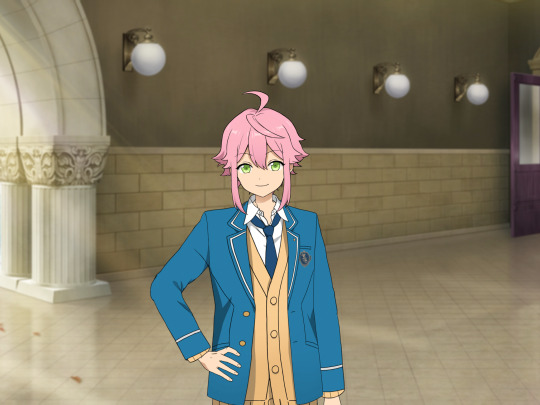
Tori: Hey, Anzu, how are everyone else's candids like?
Can you show me the pictures you've taken so far? Thanks.
...Huh, everyone has their own unique look. It's impressive how their individuality comes through so strongly.
I was only thinking about the performance, but I guess I need to consider the type of pictures I want to present too. Ugh~
...Huh? You're saying I don't need to overthink it?
I see. When I'm worried, it shows on my face, and it won't look like a candid. Yeah, I'll try to be natural.
Mitsuru: ...He~ey!
Tori: Ah, Mitsuru came running.
What's up? You need something from us?
Mitsuru: Nah! I don't have any business here, but since I spotted you two, I came over this way!
I'm so lucky to meet Anzu-neechan! What're you doing with Hime-chan?
...A photoshoot for a pamphlet? That's why you're wearing an expensive camera around your neck? Makes sense!
I want my picture taken too! Hime-chan, let's pose side by side! Peace, peace! ☆
Tori: Peace, peace...♪
I mean, hey! It's not that kind of picture.
It's for my solo live—a "Feature Live".
Mitsuru: Solo? Then it'd be bad for me to interrupt you, bye-bye!
Tori: Ah, yeah... Bye-bye...?
...He's gone. In the past, he would've said something like "Let's dash together, daze! ☆" and dragged me away.
He's a second-year now. I guess he's matured in his own way.
Well, I'm still the more mature one, though~♪
Location: Yumenosaki Academy Grower Barn
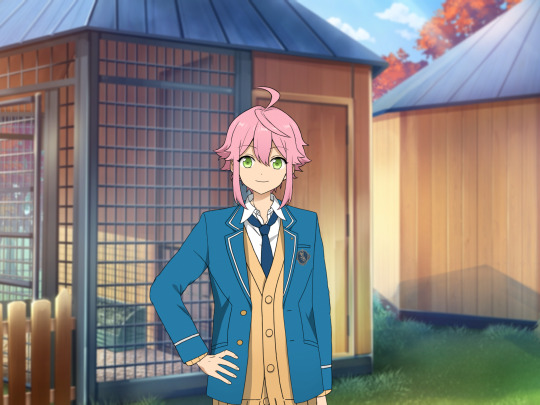
Tori: ...Oh, look. There's Shinobu.
Shinobu: Hey there! Tori-kun and Anzu-dono, what a coincidence to meet you here of all places, de gozaru!
Tori: Same to you. Why are you in the rabbit hutch? Is it like some kind of hidden village?
Shinobu: Waah, I didn't expect that kind of idea! A hidden village... Fufun, my ninja blood is stirring, de gozaru ♪
At any rate, as you can see, this is the animal enclosure. While interacting with the animals, I'm doing a bit of cleaning too.
Tori: Hmm... Ah, I just thought of a good idea.
Isn't the sight of the cute me taking care of cute animals the cutest thing ever?
You were thinking the same thing, Anzu? We're on the same wavelength~
Shinobu, let me clean up too.
Shinobu: Understood. I've already taken care of the parrots, so I shall ask you to take care of the chickens.
Tori: Okay~ ...Anzu, what's up? "There's a manual there, we should skim through it"?
No need! Just change the food and water and sweep with a broom, right? Piece of cake ♪
...Umyah?!
A chicken's on my back! And this one's pecking at my leg!
Help me~! Shinobu~! Anzu~!
Shinobu: Ohh, what a passionate reception, de gozaru...
Well then, I shall take that side, and you take care of the rabbits.
Tori: Y-Yeah... The rabbit hutch is almost cleaned out. What do I have to do?
...Brushing? Do I just brush their fur with this?
Okay, I'll try. Hehe, you're squinting your eyes all comfortable...
You should be honored to have me brush your hair...♪
Ten minutes later.

Shinobu: Thanks to Tori-kun, the animal shelter has become sparkling clean, de gozaru! I'm terribly thankful, I shall shower you with my gratitude ♪
Tori: But didn't you do most of the work, Shinobu? All I did was deal with the rabbits.
But, if I was of even just a little help, I'm glad. Anzu's happy with the good photos too.
Hm? I hear cheering... Something's going on nearby. Let's go, Anzu.
Location: Yumenosaki Academy Outdoor Stage

Tori: This crowd... Ah, it's for an "S3". Now that I think about it, I vaguely recall the proposal.
I've been reading them all. They come in so frequently, it's hard to remember each one.
What is it, Anzu? "I see a familiar face"... Ah, it's true.
Hey, Shiratori.
Aira: Oh, hello~ Did you come to see the DreFes too, Himemiya-senpai?
Tori: No, Anzu and I are...
(Huh? Anzu left.)
(Oh well. She wouldn't leave me behind, surely she'll come back eventually.)
Aira: What about Anzu-san?
Tori: It's nothing. I don't know anything about this DreFes, is there a specific idol you're interested in?
Aira: Yes! There's actually a unit I've been secretly keeping an eye on.
They're not well-known yet, but they consist of only third-years.
Tori: Huh... Now that you mention it, it's full of first-year students here.
(Everyone's eyes are shining, waiting eagerly for the live to start.)
(...It's just like how I used to be, looking up to Eichi-sama's singing and dancing on stage.)
......
Ah, Anzu, where were you? You're already hard to track, so don't just disappear suddenly, okay?
...A cyalume? You want me to evaluate them?
Sure, but I won't just wave it around so easily. I'm not lenient, y'know.
After a while, at the end of the DreFes.

Tori: Are the results announced yet... W-Well, it's not like I'm looking forward to it or anything, alright?
I'm just curious to see if the unit I waved my cyalume for won... Just a little...
Hey, can I tell you something? I was thinking about my solo live while watching the DreFes.
I haven't figured out all the details yet, but I want to make it a performance that becomes a goal for anyone who sees it.
Kids like the ones I met at Yumenosaki Academy and ES... I want the idols that I used to ignore to like me.
But I don't know what exactly to do... Will you think about it with me?
...Ehehe. Thanks. I knew you'd say that, Anzu.
I became an idol because I admired Eichi-sama. Even if it's just a single person, I hope I can become someone's inspiration too...♪
← Previous ✧ Directory
11 notes
·
View notes
Photo

Understanding Rabbit Hutch Basics Important Features for a Healthy Hutch Selecting the Right Location Materials and Tools Overview Planning Your Rabbit Hutch Design Free DIY Plans for Small Hutches A-Frame Hutch Construction Guide Sectional Hutch Step-by-Step Instructions Constructing the Hutch Frame Framing the Basic Structure Constructing Front and Back Sections Assembling Hutch Legs Enhancing Structural […] The post DIY Rabbit Hutch: 8 Free Plans for Building a Perfect Outdoor Home appeared first on The Homestead Survival .
2 notes
·
View notes
Text
Very odd to see people insisting domestic rabbits need to outdoor free-roam to have a good wellbeing because while yeah being a house rabbit has its limitations (no digging and not the same amount of natural stimuli) you can work around it by bringing in grass and logs and providing games and hiding spots (and tbh rabbits are easy to make games for same as cats like i just give bunny cardboard boxes or make food puzzles by braiding or wrapping food items up)
But also there are risks to letting your rabbit loose even in an enclosed garden. Myxomatosis is a big risk but also digging in places it isnt safe to and like as with any other animal you do need to monitor them outside lest they eat something they shouldnt or hurt themselves on something.
I let bunny roam but only on days im home and he wears a little bell so i can keep track of where he is, and more often he just has indoor time because i can do that every day and regardless of weather (and because i can better monitor his diet)
But i have a fully enclosed yard and a rabbit who shows no interest in digging anything more than a shallow indent so im able to feel safe because i know he wont escape or burrow somewhere unstable.
Which has happened. I owned rabbits as a kid who had been allowed to free roam unsupervised from birth and i was too young to know how to adjust them to regular handling and hutch living. And they did on multiple occassions escape onto roads and wound up burrowing under their (floorless) hutch and then contracted myxomatosis and died in the burrow where we couldnt reach them.
And yeah a big chunk of it was i was like 10 and not at all capable of that responsibility but it was really not helped by the fact that the rabbits i recieved had not been trained in any capacity.
Like its very visible now how much better bunny's life is than his predecessors, hes much less stressed, hes used to being in a hutch so i know hes safe at night, he's house-trained and has regular social time with us. And while sometimes he gets ansty and makes an escape when i open my door he has never left the yard and is much more willing to be retrieved.
Like what i mean i guess is training a rabbit early on to be handled and to live in a hutch with scheduled time either outdoors or indoors is much safer and happier in the long term i think.
And like with cats its not a matter of needing the ability to free roam outdoors at the cost of safety its a matter of needing regular enrichment which can in fact be provided indoors or in a controlled way (for example rabbits can be trained to walk on leash or in my case just a harness but with supervision)
2 notes
·
View notes
Text
This is an EXTREMELY niche addendum, but it's coming from a place of tragedy here so just. Yeah
If you have an outdoor rabbit hutch with male and female rabbits (that are not fixed), just be aware that- at least some male rabbits- will not stop having sex to cool down or rehydrate. If there are several females between him and the water bowl, that water bowl may still be his last priority. Even if it kills him.
Just, account for that and plan accordingly.
And RIP Hazel Dibbuns. I loved you, and at least you died doing what you loved I guess.
For all of the northerners that stood up for Texas during our freeze and said, "Don't make fun of them, they've never dealt with this before. Their infrastructure isn't made for snow and freezing."
This one is for you.
Where I live 108°F with 80% humidity with no wind is normal.
Pacific North West is dealing historic best waves 35-40°C or 95-105°F.
First of all. Don't make fun of them for bitching about the heat. Just like Texas isn't built for a freeze and our pipes burst, Pacific North West isn't built for heat and a lot of their homes don't have AC.
If you live somewhere with a high humidity like 80+ HUMIDITY IS NOT YOUR FRIEND. The "humidity makes it feel cooler" is a lie once it gets beyond a point.
If you live somewhere with a lower humidity, misters are nice to cool off outside.
Once you get over 90°F (32°C) a fan will not help you. It's just pushing around hot air. (I mean if you can't afford a small AC unit because they're expensive as hell, by all means a fan is better than nothing).
If you have pets, those portable AC units aren't safe. If your pets destroy the outtake thing, it'll leak CO2. Window units are safer.
Window AC units will let mosquitoes or other small bugs in. Sucks, but that's life.
Now is not the time to me modest. If you have to cover for religious reasons, by all means. If you don't, I've seen people wear short shorts and a swim top. It's not trashy if it keeps you from getting heat stroke.
If you do have to cover up for religious reasons, look for elephant pants or something similar. They're made with a breathable material.
Shade is better than no shade, but that shit it just diet sun after some point. Don't think shade will save you from heat stroke.
I know the "drink your water" is a fun meme now, but if you're sweating excessively you need electrolytes. Drink Gatorade, Powerade, or Pedialite PLEASE. I don't care if you're fucking sitting in one spot all day. That shit WILL save you from heat stroke.
Most importantly. RESEARCH THE DIFFERENCE BETWEEN HEAT STROKE AND HEAT EXHAUSTION PLEASE!
If you're diabetic and can't drink Gatorade, mix water, fruit juice, and either lite salt or pink salt
If you can afford it, cover windows with thick curtains to insulate the house
If you have tile floors, lay on them with skin to tile contact. If you don't, laying your head on cool counters works too.
If the temperature where you're at is hotter than your body temperature, don't wear heat wicking clothing. Moisture wicking is safe though.
Check your medication labels. Many make you more susceptible to sun and heat
-Room temperature water will get into your body faster. This is something I learned doing marching band in high summer in Georgia, and it saved all of our asses. Sip it, don't gulp it, especially if you're getting into the red; same goes for whatever fluid you're drinking. And just in general drink during the day.
-If you are moving from an air conditioned space to an un-air conditioned space, if at all possible try to make the shift gradual. When my dad and I were working outside and in un-ac houses a few years ago, he'd turn the air down to low in the truck about ten-fifteen minutes before we got where we were going. This way your body doesn't go from low low temps to high temps. S'bad for you.
-If you can, keep your lights off during the day. Light bulbs may not generate a lot of heat, but the difference is noticeable when it gets hot enough. I literally only turn my bedroom light on in the evening when it gets too dark.
Don't be afraid to just like... pour water on yourself if you need to. The evaporation will cool you off.
Put your hand to the cement for 15 seconds. If you can't handle the heat, it'll burn your dog's paws. Don't let them walk on it.
Dogs with flat faces are more prone to heat stroke. Don't leave them out unsupervised.
Frozen fruit is delicious in water.
Wet/Cold hat/handkerchief on your head/neck will help you stay cool.
Pickle juice is great for electrolytes! You can even make pickle juice Popsicles!
Heat exhaustion is more, "drink water and get you cooled off." Heat stroke is more "Oh my god call 911."

Image Description provided by @loveize
[Image description: an infographic showing the difference between heat exhaustion and heat stroke. The graphic is labeled "Heat Dangers: First Warning." Signs of heat exhaustion: faint or dizzy, excessive sweating, cool, pale, clammy skin, rapid, weak pulse, muscle cramps. If you think you or someone else may be experiencing heat exhaustion, get to a cool, air-conditioned place, drink water if conscious, and take a cool shower or use cold compress. Signs of heat stroke: throbbing headache, no sweating, red, hot, dry skin, rapid, strong pulse, may lose consciousness. If you think you or someone else may be experiencing heat stroke, call 911. End description]
Be safe.
-fae
#I'm not joking#My sweet boy went into rigor mortis with a full erection#I can see the humor in the situation as an adult#but that took 20 years okay losing a pet is always devastating#tw animal death
122K notes
·
View notes
Text
#ComfortForPets#HappyPetsHappyLife#PetFriendlySpaces#OutdoorLivingWithPets#PetComfortTips#OutdoorSpaceIdeas#PetLoversParadise#EnhanceYourOutdoorSpace#PetsAndOutdoors#OutdoorComfortForPets#PetFriendlyOutdoorDesign#PetCareIdeas#PetComfortEssentials#BackyardForPets#RelaxingWithPets#CreatePetFriendlySpaces#OutdoorSpacesForPets#PetLoversOutdoorTips#ComfortablePetsHappyOwners#OutdoorComfortIdeas#PetFriendlyBackyard#PetsDeserveComfort#OutdoorEnhancementsForPets#PetCareAndComfort#CozySpacesForPets#RelaxingOutdoorSpaces#PetsAndNature#PetComfortAndCare#OutdoorOasisForPets#PetsInTheBackyard
0 notes
Photo

What Makes the Thrianta Rabbit Breed So Rare? Uncovering the Mystery of the Thrianta Rabbit Breed? Uncovering the Mystery of the Thrianta Rabbit's Short Head How Does the Thrianta Rabbit's Short Neck Affect its Rarity? Uncovering the Unique Features of the Thrianta Rabbit? Why is the Thrianta Rabbit's Coat Color So Unique? Thrianta rabbits are friendly pets that make great first-time pet owners or families with young children feel at ease when taking on new pets. Indoor or outdoor living arrangements are suitable as long as their hutch is raised off the ground to protect it from predators. These rabbits relish getting out of their enclosures every day to stretch their legs and socialise with other non-threatening pets. https://backyardbunnynews.com/what-makes-the-thrianta-rabbit-breed-so-rare/?feed_id=8473&_unique_id=6707b428c8102
0 notes
Text
The Complete Guide to Angora Rabbits that You Need to Know- Your Pet Diary

History and Origins of Angora Rabbits
The Angora rabbit has a rich history that dates back to ancient times. Originating in Ankara (historically known as Angora) in Turkey, these rabbits were prized for their long, soft wool. By the mid-18th century, Angora rabbits had made their way to Europe, where they quickly gained popularity among the French aristocracy. They were eventually introduced to America in the early 20th century, where they continue to be bred both as pets and for their valuable wool.
Types of Angora Rabbits
There are several breeds of Angora rabbits, each with its own unique characteristics and wool types. The four main breeds are:
English Angora: Known for their dense and silky wool, English Angoras are small to medium-sized rabbits with a friendly disposition. Because of their thick coat they require regular grooming.
French Angora: Larger than the English variety, French Angoras have a coarser wool that is easier to care for. They have a docile nature and are often preferred by those who spin wool.
Giant Angora: The largest of the Angora breeds, Giant Angoras produce a significant amount of wool. They have a calm temperament and are particularly valued for their high wool yield.
Satin Angora: Recognized for their shiny, soft wool, Satin Angoras have a unique sheen to their fur. They are medium-sized rabbits and are cherished for their beautiful wool, which has a fine texture.
Characteristics and Temperament
Angora rabbits are known for their gentle and affectionate nature. They make excellent pets due to their friendly disposition and relatively calm demeanor. However, they do require a considerable amount of care, particularly when it comes to grooming. Regular handling and socialization from a young age can help Angora rabbits become well-adjusted and comfortable around humans.
Physically, Angora rabbits are distinguished by their long, fluffy wool, which can grow up to several inches in length. Their ears are typically upright, and their eyes can be blue or brown. The average lifespan of an Angora rabbit is around 7-12 years, depending on the care they receive and their living conditions.
Housing and Care Requirements
Proper housing and care are crucial for the health and well-being of Angora rabbits. Here are some key considerations:
Housing
Space: Angora rabbits need ample space to move around and exercise. A spacious hutch or cage with enough room for them to hop and stretch is essential. The enclosure should be at least four times the size of the rabbit when fully stretched out.
Bedding: Use soft, absorbent bedding such as straw or hay to keep the rabbit comfortable. Avoid using cedar or pine shavings, as these can be harmful to rabbits.
Temperature: Angora rabbits are sensitive to extreme temperatures. Keep their environment cool in the summer and warm in the winter. They should be kept indoors or in a well-insulated outdoor hutch.
Diet
A balanced diet is essential for the health of Angora rabbits. Their diet should consist of:
Hay: The primary component of an Angora rabbit’s diet should be high-quality hay, such as timothy hay or orchard grass.
Pellets: Supplement their diet with rabbit pellets that are high in fiber and low in protein. Avoid pellets with added seeds or dried fruit.
Fresh Vegetables: Offer a variety of fresh vegetables daily, such as leafy greens, carrots, and bell peppers.
Water: Always provide fresh, clean water.
Grooming
Regular grooming is critical for Angora rabbits due to their dense wool. Neglecting grooming can lead to matting and health issues. Here are some grooming tips:
Brushing: Brush your Angora rabbit at least twice a week, using a slicker brush or a comb designed for long-haired animals. This helps prevent mats and removes loose wool.
Trimming: Regularly trim the wool around their face, ears, and feet to keep them clean and comfortable. Professional grooming every few months may be necessary.
Shearing: Angora rabbits need to be sheared every 3-4 months to harvest their wool and prevent matting.
Health Concerns
Angora rabbits are generally healthy, but they are prone to specific health issues due to their wool and breeding. Some common health concerns include:
Wool Block: This condition occurs when a rabbit ingests too much wool while grooming, leading to a blockage in their digestive system. Prevent wool block by providing a high-fiber diet, regular grooming, and plenty of fresh water.
Dental Problems: Like all rabbits, Angoras have continuously growing teeth. Ensure they have access to chew toys and a diet high in hay to keep their teeth worn down.
Parasites: Angora rabbits can be susceptible to parasites such as mites and fleas. Regularly check their skin and coat for signs of infestation and consult a veterinarian if needed.
Harvesting and Using Angora Wool
One of the most appealing aspects of Angora rabbits is their luxurious wool, which is highly prized in the textile industry. Here’s how to harvest and use Angora wool:
Harvesting Wool
Shearing: Shearing involves cutting the wool close to the rabbit’s skin using scissors or electric clippers. This method is quick and ensures a clean cut.
Plucking: Plucking is a gentler method where loose wool is gently pulled from the rabbit’s coat. This method is less stressful for the rabbit but can be time-consuming.
Combing: Regular brushing or combing can also help collect wool, particularly during the rabbit’s natural shedding periods.
Using Wool
Angora wool is incredibly soft, warm, and lightweight, making it ideal for various textile projects. It can be spun into yarn for knitting or crocheting garments such as sweaters, hats, and scarves. The wolf’s fine texture and natural sheen add a touch of luxury to any handmade item.
Breeding Angora Rabbits
Breeding Angora rabbits requires careful planning and knowledge. Here are some key points to consider:
Selection: Choose healthy rabbits with desirable traits for breeding. Ensure they are free from genetic defects and health issues.
Mating: Introduce the male (buck) to the female’s (doe) enclosure. Mating typically occurs quickly, and the doe should be separated from the buck afterward.
Pregnancy and Birth: The gestation period for rabbits is around 31 days. Provide a nesting box for the doe to give birth. Monitor the mother and kits (baby rabbits) closely to ensure they are healthy.
The Joy of Owning Angora Rabbits
Owning an Angora rabbit can be a rewarding experience. These gentle and affectionate creatures make wonderful pets, offering both companionship and the added benefit of producing beautiful wool. With proper care and attention, Angora rabbits can thrive and bring joy to their owners for many years.
Inference
Angora rabbits are truly remarkable animals, cherished for their soft, luxurious wool and gentle nature. By understanding their history, care requirements, and the unique qualities of their wool, you can provide the best possible environment for these delightful creatures. Whether you’re a pet owner, a fiber enthusiast, or simply an admirer of Angora rabbits, this guide offers a comprehensive overview to help you appreciate and care for these wonderful animals.
By following the guidelines outlined in this article, you’ll be well-equipped to provide a happy, healthy life for your Angora rabbit and enjoy the many benefits they bring. Link : https://yourpetdiary.com/angora-rabbits/
0 notes
Text
So much useful and easy to understand information here!
Your cats do not belong outside. Your dogs do not belong outside. Your fish and lizards and scaly pets that you no longer find cute anymore do not belong in outside. Your pets are not wild animals, you are not "denying their natural instinct" by keeping them inside. it is not animal abuse to keep your domesticated animals inside. It is animal abuse, or at least neglect, to leave your pets unattended outside for extensive periods of time.
There is no such thing as an outdoor pet. Even rabbits need a hutch. Even chickens need a coop. Your pets do not belong outside.




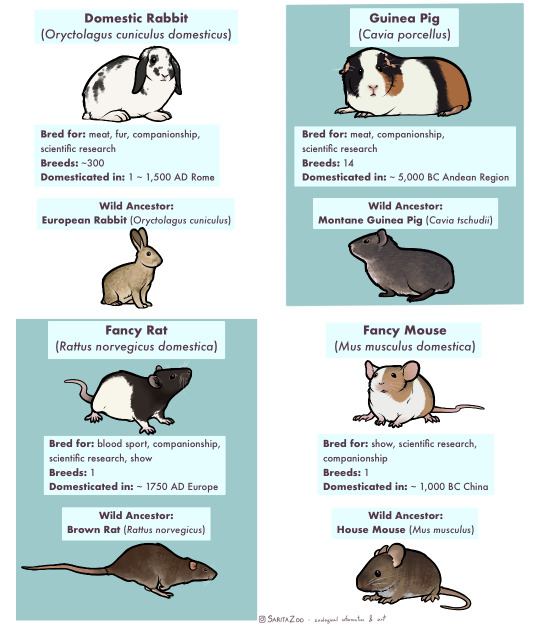
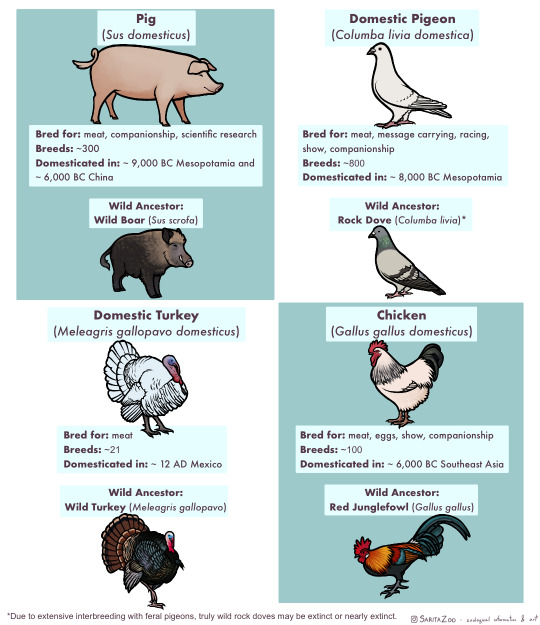
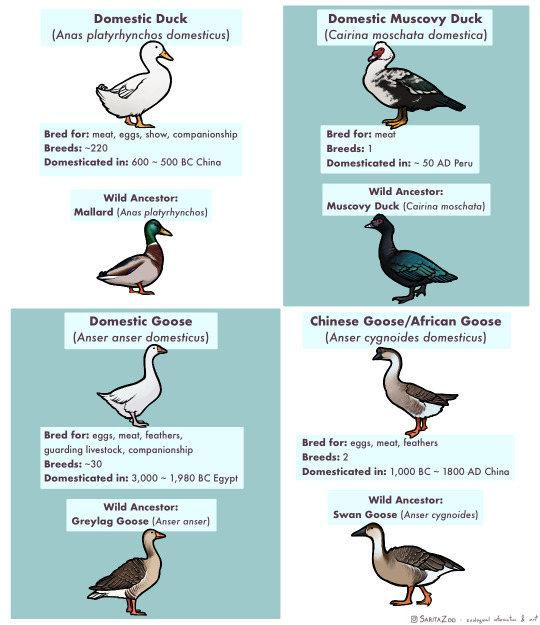
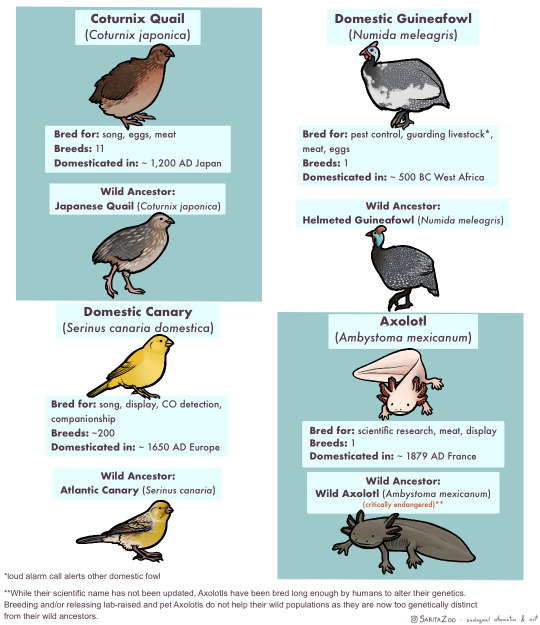
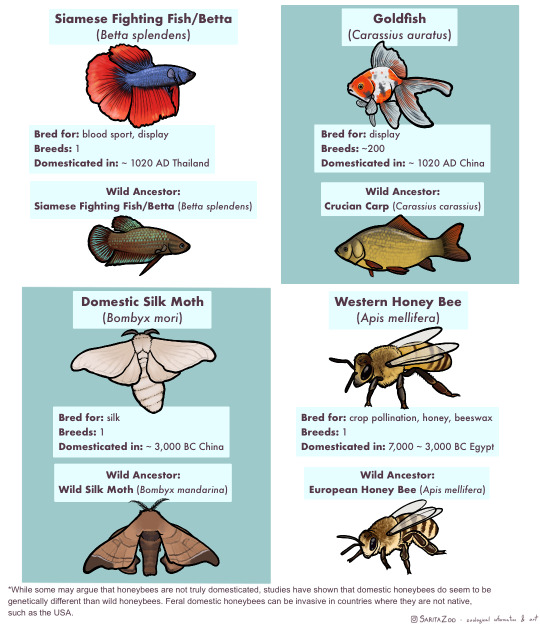

Phew. This one took, uh… a bit longer than expected due to other projects both irl and art-wise, but it’s finally here. The long-awaited domestic animal infographic! Unfortunately, I didn’t have enough space to cover every single domestic animal (I’m so sorry, reindeer and koi, my beloveds) but I tried to include as many of the “major ones” as possible.
I made this chart in response to a lot of the misunderstandings I hear concerning domestic animals, so I hope it’s helpful!
Further information I didn’t have any room to add or expand on:
🐈 “Breed” and “species” are not synonyms! Breeds are specific to domesticated animals. A Bengal Tiger is a species of tiger. A Siamese is a breed of domestic cat.
🐀 Different colors are also not what makes a breed. A breed is determined by having genetics that are unique to that breed. So a “bluenose pitbull” is not a different breed from a “rednose pitbull”, but an American Pitbull Terrier is a different breed from an American Bully! Animals that have been domesticated for longer tend to have more seperate breeds as these differing genetics have had time to develop.
🐕 It takes hundreds of generations for an animal to become domesticated. While the “domesticated fox experiment” had interesting results, there were not enough generations involved for the foxes to become truly domesticated and their differences from wild foxes were more due to epigenetics (heritable traits that do not change the DNA sequence but rather activate or deactivate parts of it; owed to the specific circumstances of its parents’ behavior and environment.)
🐎 Wild animals that are raised in human care are not domesticated, but they can be considered “tamed.” This means that they still have all their wild instincts, but are less inclined to attack or be frightened of humans. A wild animal that lives in the wild but near human settlements and is less afraid of humans is considered “habituated.” Tamed and habituated animals are not any less dangerous than wild animals, and should still be treated with the same respect. Foxes, otters, raccoons, servals, caracals, bush babies, opossums, owls, monkeys, alligators, and other wild animals can be tamed or habituated, but they have not undergone hundreds of generations of domestication, so they are not domesticated animals.
🐄 Also, as seen above, these animals have all been domesticated for a reason, be it food, transport, pest control, or otherwise, at a time when less practical options existed. There is no benefit to domesticating other species in the modern day, so if you’ve got a hankering for keeping a wild animal as a pet, instead try to find the domestic equivalent of that wild animal! There are several dog breeds that look and behave like wolves or foxes, pigeons and chickens can make great pet birds and have hundreds of colorful fancy breeds, rats can be just as intelligent and social as a small monkey (and less expensive and dangerous to boot,) and ferrets are pretty darn close to minks and otters! There’s no need to keep a wolf in a house when our ancestors have already spent 20,000+ years to make them house-compatible.
🐖 This was stated in the infographic, but I feel like I must again reiterate that domestic animals do not belong in the wild, and often become invasive when feral. Their genetics have been specifically altered in such a way that they depend on humans for optimal health. We are their habitat. This is why you only really see feral pigeons in cities, and feral cats around settlements. They are specifically adapted to live with humans, so they stay even when unwanted. However, this does not mean they should live in a way that doesn’t put their health and comfort as a top priority! If we are their world, it is our duty to make it as good as possible. Please research any pet you get before bringing them home!
#domestic animals#domestication#dogs#pets#cats#environmentalism#feral cats#are not wild animals#what they are is#invasive species#really fucking detrimental ones too
33K notes
·
View notes